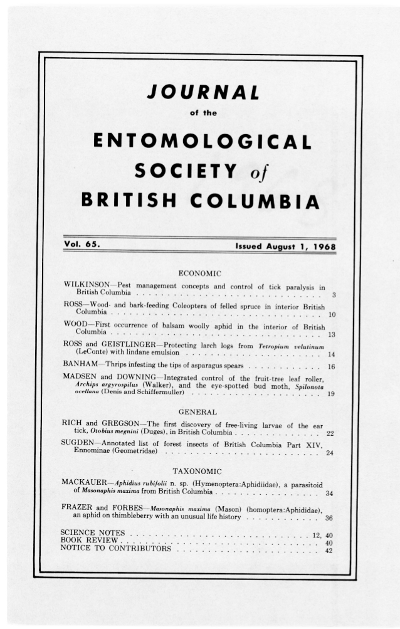Integrated control of the fruit-tree leaf roller, <i>Archips argyrospilus</i> (Walker), and the eye-spotted bud moth, <i>Spilonota ocellana</i> (Denis & Schiffermuller)
Keywords:
fruit-tree leaf roller, <i>Archips argyrospilus</i>, eye-spotted bud moth, <i>Spilonota ocellana</i>Abstract
Pre-bloom sprays to control the fruit-tree leafroller, <i>Archips argyropilus</i> (Walker), and the eye-spotted bud moth, <i>Spilonota ocellana</i> (Denis & Schiffermuller), were applied in an apple orchard where no insecticides have been used for 6 years. The phytophagous mites in the orchard are held under control by predacious phytoseiid mites. Azinphos-methyl at 5 and 2 1/2 lb. 25% W.P. per acre gave excellent control of the two insects when applied at the pre-pink stage. Dormant oil at 6 gal. per acre applied at the l/2-inch green stage was ineffective. Oil at 6 gal. and azinphos-methyl at 2 1\2 lb. did not reduce predacious phytoseiid mites over the untreated control. No phytoseiid mites were found on trees treated with azinphos-methyl at 5 lb. The timing at the effective sprays would not interfere with a program of codling moth control by the sterility method.References
Downing, R.S. and T.K. Moilliet. 1967. Relative densities of predacious and phytophagous mites on three varieties of apple trees. Can. Entomol. 99:738-741.
Henderson, C.F. and H.Y. McBurnie. 1943. Sampling technique for determining populations of citrus red mite and its predators. U.S. Dept. Agr. Circ. 671.
Madsen, H.F. and J.C. Arrand. 1966. The recognition and biology of orchard insects and mites in British Columbia. Brit. Columbia Dept. Agr. Entomol. Branch 66-2.
Proverbs, M.D., J.R. Newton, and D.M. Logan. 1967. Autocidal control of the codling moth by release of males and females sterilized as adults by gamma radiation. J. Econ. Entomol. 60:1302-1306.
Downloads
Published
Issue
Section
License
Authors who publish with the Journal of the Entomological Society of British Columbia agree to the following terms:
-Authors retain copyright and grant the journal right of first publication with the work simultaneously licensed under a Creative Commons Attribution License that allows others to share the work with an acknowledgement of the work's authorship and initial publication in this journal.
-Authors are able to enter into separate, additional contractual arrangements for the non-exclusive distribution of the journal's published version of the work (e.g., post it to an institutional repository or publish it in a book), with an acknowledgement of its initial publication in this journal.
-Authors are permitted and encouraged to post their work online (e.g., in institutional repositories or on their website) prior to and during the submission process, as it can lead to productive exchanges, as well as earlier and greater citation of published work (See The Effect of Open Access).


